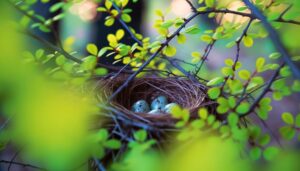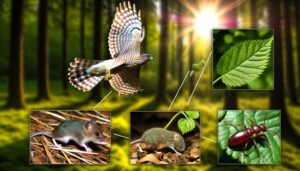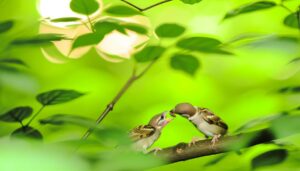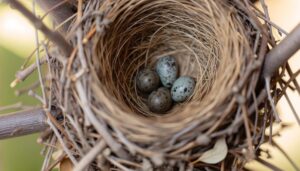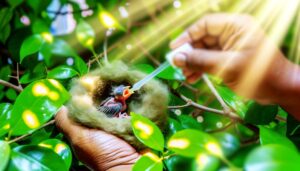Step-by-Step Help for a Sparrow’s Broken Wing
Helping a sparrow with a broken wing involves a detailed and empathetic approach. Begin by carefully observing and evaluating the bird's condition.
Prepare a secure, peaceful recovery space with appropriate bedding and warmth. Approach and handle the sparrow gently, supporting its body and minimizing stress.
Examine the wing closely for visible injuries or fractures. Record daily observations on its behavior and physical condition to monitor progress.
Use this data to make informed decisions about rehabilitation. Consistent, compassionate care is essential for successful recovery.
For a detailed guide on creating a tailored recovery plan and providing ongoing support, continue below.
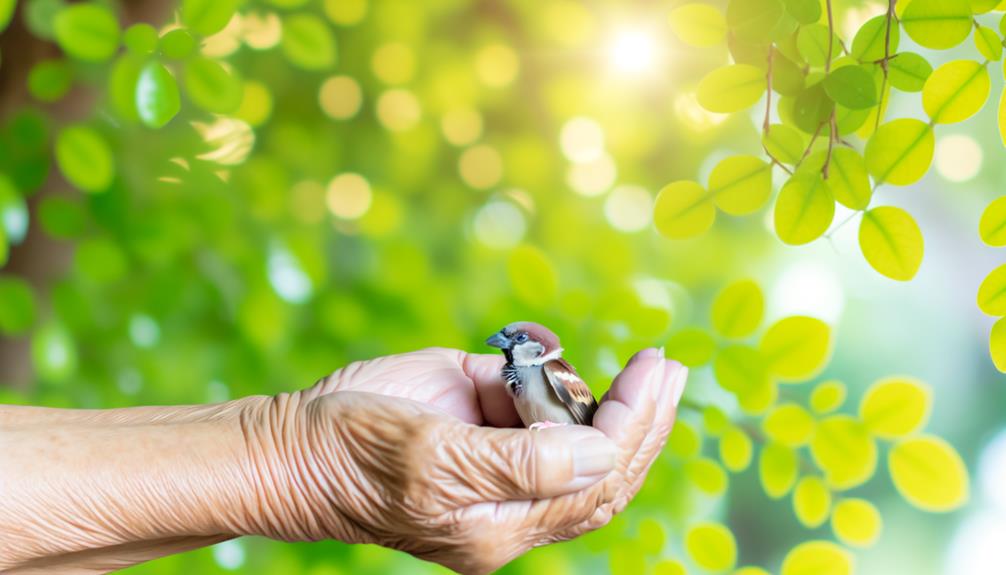
Key Takeaways
- Observe the sparrow's condition and prepare a quiet recovery space with appropriate bedding and temperature control.
- Approach the sparrow calmly, handle gently, and wrap it in a soft cloth to minimize stress.
- Inspect the wing for visible injuries and fractures using a magnifying glass and note the bird's response to touch.
- Monitor the sparrow's daily behavior, feeding patterns, and physical condition to track recovery progress.
- Consult with wildlife experts for specialized care and adapt rehabilitation strategies based on ongoing observations.
Assess the Situation
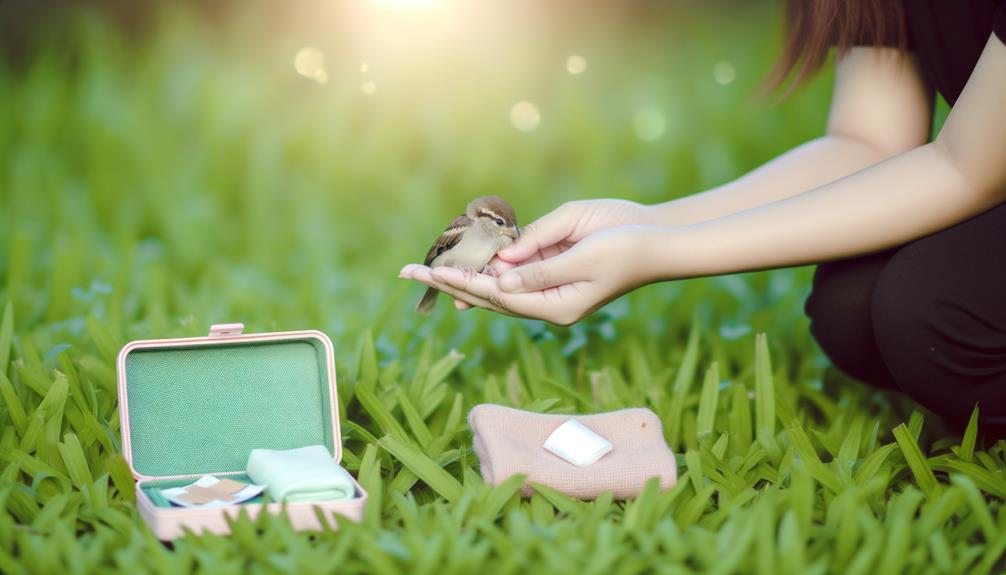
Before taking any action to assist a sparrow with a broken wing, it is important to carefully observe and evaluate the bird's current condition and immediate environment. First, determine if the sparrow is in immediate danger from predators or environmental hazards. Look for signs of distress, such as rapid breathing, fluffed feathers, or lethargy.
Assess the extent of the injury by observing the wing's position and any visible wounds. Additionally, note the bird's behavior; a sparrow in severe pain may exhibit erratic movements or vocalizations. Guarantee the area is calm and free of disturbances to reduce the bird's stress levels. Understanding these factors will guide subsequent steps and ensure the sparrow receives appropriate care.
Prepare a Safe Space
Creating a secure and quiet environment is crucial for the sparrow's recovery and well-being. Begin by selecting a small box or a ventilated container to serve as the sparrow's temporary habitat. Line the bottom with soft materials such as clean cloth or paper towels to provide comfort and insulation.
Ensure the container is placed in a warm, dimly lit area away from noise and disturbances, as stress can worsen the bird's condition. Maintain a stable temperature by avoiding drafts and direct sunlight. If possible, use a heating pad set on low beneath half of the container to offer a gradient of warmth.
Regularly check the bedding to keep it clean and dry, promoting a hygienic recovery space.
Approach the Sparrow
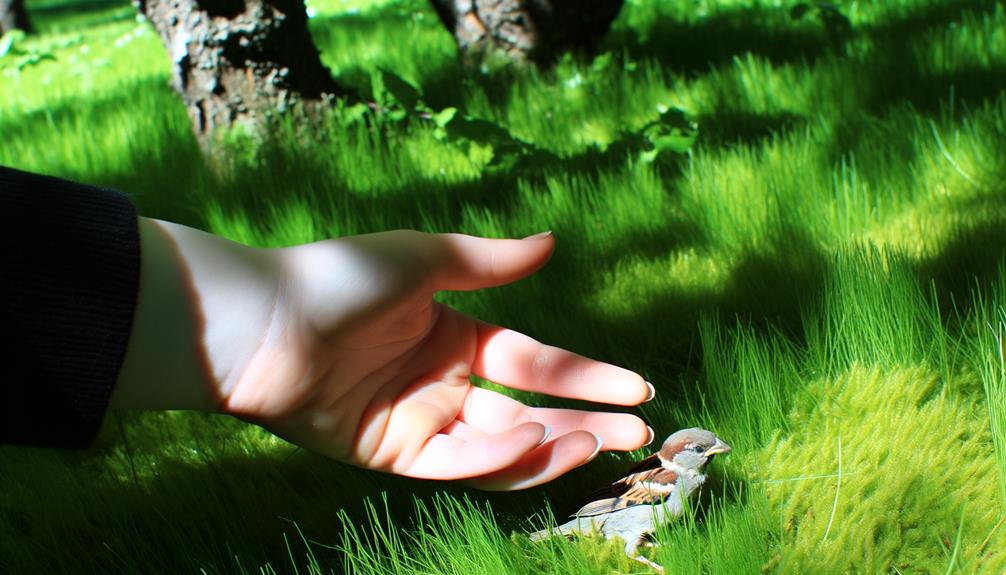
Approach the sparrow slowly and calmly to minimize stress and reduce the risk of further injury. Maintain a low profile and move gradually, as sudden movements can startle the bird, worsening its condition.
Speak softly to reassure the sparrow and prevent it from feeling threatened. Make sure your hands are visible, reducing the perception of danger. Observing the bird's behavior is essential; if it appears agitated, pause and give it time to acclimate to your presence.
Use a gentle demeanor, as sparrows are small and delicate, making them highly vulnerable to stress. Ensuring a peaceful environment will further help in keeping the sparrow calm. Approach from the side rather than above, imitating natural, less-intimidating movement patterns.
Handle With Care
When handling the sparrow, make certain you use both hands to gently but firmly support its body, minimizing movement to prevent further injury. Position one hand over the bird's back, cupping it softly, while the other hand supports its legs and chest. Make certain your grip is secure but not too tight, as excessive pressure can cause additional stress or harm.
Use a soft cloth or towel to wrap the sparrow, providing a sense of security and reducing flapping. Be mindful of the bird's breathing; if it appears labored, loosen your hold slightly.
Throughout the process, maintain a calm demeanor and speak softly to avoid startling the bird, fostering a more relaxed environment for both you and the sparrow.
Examine the Injury
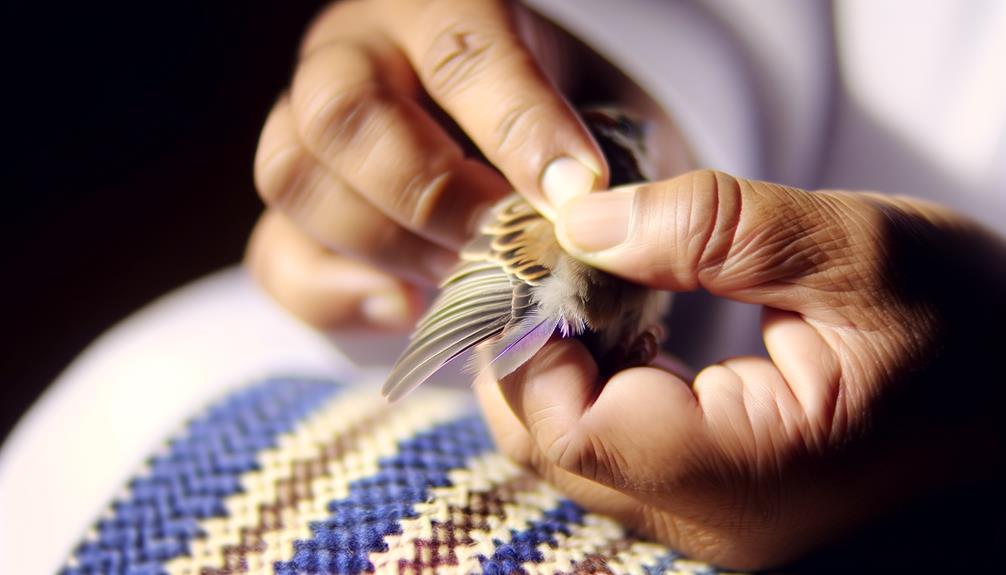
Carefully inspect the sparrow's wing for visible signs of injury, including swelling, misalignment, or open wounds.
Gently extend the wing, observing any unnatural angles or resistance, which may indicate a fracture.
Look for areas of discoloration, which can signify bruising or internal bleeding.
Utilize a magnifying glass for a closer examination of feathers and skin, ensuring no small puncture wounds are overlooked.
Note the bird's response to touch; excessive pain or distress can provide additional clues about the injury's significance.
Keep the environment quiet and calm to minimize stress.
Document all observations meticulously, as this information will be essential for providing accurate care and communicating with a wildlife rehabilitator or veterinarian.
Provide Initial Treatment
Administering initial treatment to a sparrow with a broken wing requires both delicate handling and precise actions to stabilize the injury and alleviate the bird's discomfort. Begin by gently restraining the sparrow to prevent further injury.
Next, assess for open wounds or bleeding, applying a sterile dressing if necessary. Immobilize the wing using a small splint or tape to prevent movement and promote healing. Guarantee the sparrow is kept warm and calm during the process.
Key steps include:
- Restrain gently: Use minimal force to avoid additional stress or harm.
- Assess for wounds: Look for and address any open injuries.
- Immobilize the wing: Utilize splints or tape appropriately.
- Maintain warmth and calm: Minimize stress to aid recovery.
Create a Recovery Plan
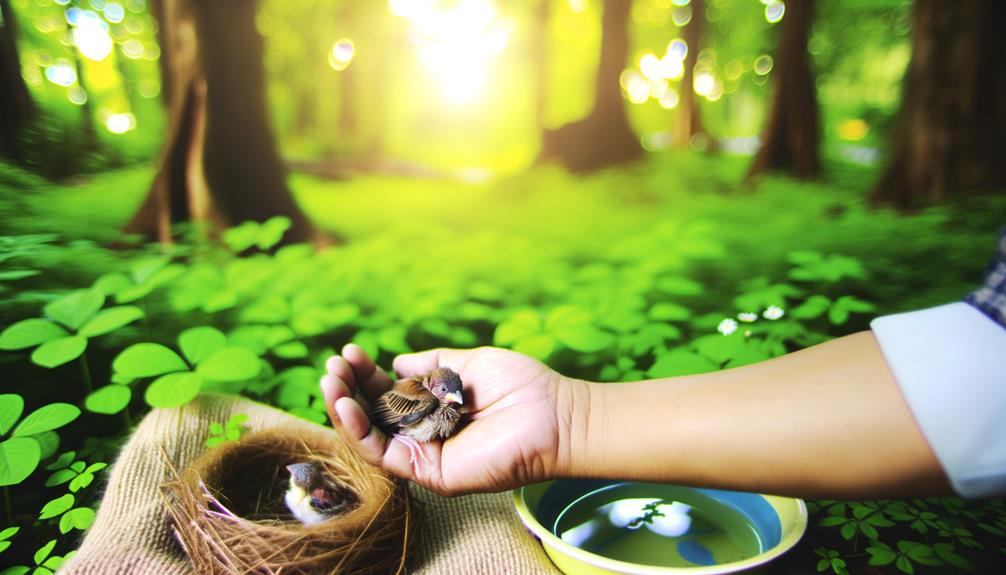
To guarantee a successful recovery for a sparrow with a broken wing, it is vital to establish a designated recovery area that minimizes stress and allows for safe healing.
Providing appropriate nutritional support is essential to strengthen the bird's immune system and facilitate tissue repair.
Continuous monitoring of the healing progress will enable timely interventions and adjustments to the care plan as necessary.
Designated Recovery Area
Establishing a designated recovery area is vital to make sure the sparrow's broken wing heals in a safe, controlled environment. This space should be carefully prepared to minimize stress and prevent further injury. Ideally, the area should be quiet, away from predators, and provide the necessary conditions for recuperation.
- Enclosure Size: Ensure the enclosure is small enough to limit excessive movement but spacious enough for comfort.
- Temperature Control: Maintain a stable, warm temperature to support the bird's healing process.
- Soft Bedding: Use soft materials like towels or paper towels to cushion the sparrow and prevent pressure sores.
- Cleanliness: Regularly clean the area to prevent infections and promote a hygienic recovery environment.
These steps will facilitate best healing conditions for the sparrow.
Nutritional Support Essentials
Ensuring the sparrow receives proper nourishment is crucial to its recovery, as a balanced diet rich in essential nutrients can greatly speed up the healing process of a broken wing.
Provide high-protein foods such as mealworms, which aid in tissue repair and muscle strength. Incorporate seeds and grains to supply necessary carbohydrates and fats.
Fresh fruits and vegetables should be included to offer vitamins and minerals, particularly calcium and vitamin D, essential for bone regeneration.
Hydration is equally important; guarantee constant access to clean, fresh water. Supplements, like avian vitamins, can be helpful but should be administered under veterinary guidance.
This thorough nutritional plan will support the sparrow's metabolic needs, fostering a conducive environment for recovery.
Monitoring Healing Progress
Once the sparrow's nutritional needs are met, systematic monitoring of its healing progress becomes crucial to secure a successful recovery. Evaluating the sparrow's condition requires a detailed recovery plan. Key components include:
- Daily Observations: Check for signs of pain, swelling, or changes in behavior. Record any abnormalities.
- Regular Weight Checks: Monitor the sparrow's weight to ensure it is maintaining or gaining appropriately.
- Controlled Movement: Gradually allow the sparrow limited exercise to prevent further injury while promoting muscle strength.
- Veterinary Follow-Ups: Schedule periodic visits to a qualified avian veterinarian for professional evaluation and adjustments to the recovery plan.
This structured approach, combined with compassion and attention to detail, will notably improve the sparrow's chances of a full recovery.
Monitor Progress
To effectively monitor the sparrow's progress, meticulously document its daily behavior, feeding patterns, and physical condition to identify any signs of improvement or deterioration. Regular monitoring allows for early detection of potential complications, ensuring timely intervention. Utilize the following table format to systematically record observations:
| Day | Behavior Observed | Feeding Patterns | Physical Condition |
|---|---|---|---|
| 1 | Minimal movement | Reduced intake | Swollen wing |
| 2 | Slightly active | Normal intake | Reduced swelling |
| 3 | Increased activity | Active feeding | Bruising subsiding |
| 4 | Normal behavior | Vigorous feeding | Wing mobility improving |
Such detailed logging offers a thorough view of the sparrow's recovery trajectory, enabling informed decisions on necessary care adjustments. Compassionate, consistent observation is critical for the sparrow's successful rehabilitation.
Conclusion
To sum up, addressing a sparrow's broken wing requires meticulous assessment and compassionate care, akin to tending to a delicate flower.
Creating a safe environment, handling the bird with utmost care, and providing appropriate initial treatment are essential steps.
Developing a structured recovery plan and closely monitoring progress are imperative for successful rehabilitation.
Through these detailed and compassionate measures, the sparrow's chances of recovery and return to the wild are greatly improved, demonstrating the profound impact of dedicated wildlife care.

